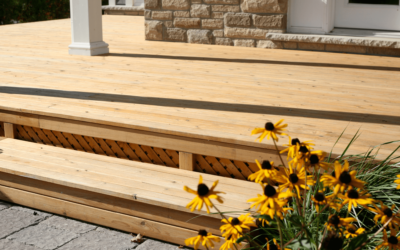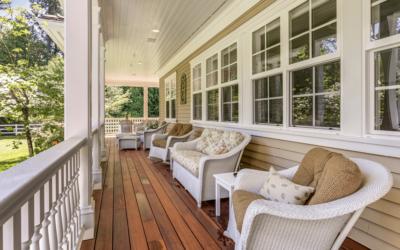Even though many modern siding materials last 20-40 years, at some point, 53% of American homeowners invest in new siding. The primary reasons for installing new siding include the replacement of damaged siding, the need to improve curb appeal, and the desire to maximize the home’s energy efficiency.
While vinyl is popular, James Hardie siding is a stiff competitor. But which is better for your project?
Read on for our comparison of Hardie board siding and vinyl siding. We’ll start with a bit of history of these two choice materials and then compare features and benefits.
A Little History
James Hardie, an international fiber cement board siding manufacturer, entered the North American market in the 1990s. The company debuted their HardiePlank lap siding at that time.
While not the only fiber siding supplier, James Hardie’s debut products drove its rise to the top, making it a leading siding material in the United States.
By the late 1960s, vinyl siding began to win fans in the home improvement market. It didn’t enjoy the same rapid popularity growth as fiber cement, but by the 1970s, vinyl was the number one choice of homeowners for siding applications.
According to data from the U.S. Census Bureau, in 2020, stucco reigned as the most common siding material (28%) for new construction homes. Vinyl ranked at 26%, with fiber cement siding at 21%.
One thing to keep in mind about data on construction materials is geographic location. There isn’t one siding material that wins in every region where the U.S. Census Bureau collects information.
Next, we’ll discuss the manufacturing process for vinyl and fiber cement board siding.
Vinyl Siding Basics
Vinyl plank siding has two layers made from different materials. The primary material in each layer is Polyvinyl Chloride (PVC).
You’re likely familiar with PVC because of its popularity as a material used in plumbing pipes and automotive parts. Vinyl siding is made mainly from PVC resin—a different form of PVC.
Vinyl siding makes an acceptable choice when you don’t want to spend a lot of time or money to get your home ready to sell. Also, continuing with your current material makes sense if you have vinyl siding and only need to repair or replace one or two damaged planks.
Hardie Board Siding
If you were to read the recipe for fiber cement siding, you’d find four essential ingredients. They include:
- Water
- Wood pulp
- Fly ash
- Portland cement
Sounds uncomplicated, right? Of course, there’s more to the manufacturing process than mixing four relatively simple ingredients.
The manufacturer processes the fiber and cement mixture as wet or dry. After processing, they press the mix into sheets and send them to a high-pressure oven for curing.
The finished product is a durable yet flexible siding panel.
Once cured, the panels go through the machining process. Finally, the sides and edges get finished and coated.
Let’s check out a few features and benefits of James Hardie siding.
Features and Benefits of James Hardie Siding
James Hardie siding shares several benefits with other siding materials, including vinyl siding, but as you’ll see, fiber cement board siding has a few unique advantages over the others.
Durability
By nature, this material stands up against weather in any climate. It’s also resistant to water damage and rot.
While vinyl siding is durable, it can’t escape the expansion and contraction experienced during heavy heat and cold. Vinyl can crack, bend, and bow, but you’ll never have that problem with Hardie siding.
Resistant to Pests
James Hardie siding doesn’t have the same vulnerability to pests as wood and vinyl siding, making it almost ironclad against termites, carpenter ants, wasps, and bees.
It’s inedible! Bugs and birds can’t chew or digest fiber cement board.
This siding is impermeable. Woodpeckers can’t drill holes in it. Insects can’t nest in it.
Fire Resistance
Along with weather and pest resistance, fiber cement siding is fire resistant. James Hardie manufactures Class-A fire-rated siding. This means it doesn’t ignite if exposed to a direct flame.
Some homeowners’ insurance providers offer discounts if you install siding with a Class-A rating. Check with your representative to see if you might qualify.
Vinyl siding isn’t recommended for homes at high risk for wildfire. South Carolina has more residents living in areas with an urban wildlife interface. This puts them at risk of encountering property-damaging wildfires.
James Hardie siding offers an additional layer of safety for you and your family.
How Long Will James Hardie Siding Last?
Don’t forget about longevity. Vinyl siding typically lasts 20-40 years if cared for properly.
Most Hardie board siding comes with a 30-year warranty. However, you can expect many more years of service if you perform simple, routine maintenance like that covered above.
Energy Efficiency and Fiber Cement Board Siding
The average single-family household spends roughly 52 percent of its energy on heating and cooling. Siding is one area where you can find potential energy expense savings.
The leading cause of energy waste in most homes is inadequate insulation. Air leakage is another contributor.
James Hardie siding has a reputation for increased thermal performance and reduced air infiltration. Regarding energy efficiency, use the right house-wrapping underneath your James Hardie siding, and you’ll likely reduce your energy costs.
Maintaining Hardie Board Siding Is Simple
Maintenance isn’t a concern for fiber cement siding as it’s practically maintenance-free. Unlike vinyl siding, you’ll never need to worry about replacing cracked planks or repairing rot.
Here’s what your maintenance program will look like:
- Remove dirt and debris with a garden hose every 6-12 months
- Clean gently with a soft brush or cloth using a side-to-side motion
- Stubborn stains can benefit from using a mild detergent
Tip: Be careful about using a high-pressure washing tool. You may damage the fiber cement surface and void your warranty.
Homeowners Love the Versatility of Fiber Cement Siding
The most attractive features of fiber cement siding include those mentioned above, but you’ll also enjoy the versatility. James Hardie siding comes in your choice of textured finishes, including:
- Wood lap boards
- Wood shake siding
- Cedar shingles
The color options are nearly endless, and this siding comes with a 15-year warranty on the finish.
One Thing to Consider Before Choosing Fiber Cement Siding
Despite its fantastic features, you’ll still need to evaluate whether this siding is best for you. The main disadvantage is cost. James Hardie siding is a premium product, which places it on the higher end of the pricing scale.
The antidote to the higher price is that your siding contractor may offer various payment solutions, which can make it affordable. Ask about special pricing programs or financing assistance when you talk with them.
If you plan to stay in your home long-term, investing in Hardie siding will give you an excellent return.
This siding is an excellent choice for homeowners planning to sell soon. You may be able to recoup up to 76% of your investment when you sell your home.
Ready to Start Your New Siding Project?
Whether you’ve decided to move forward with a premium product like James Hardie siding or you’re interested in a vinyl siding replacement, Contract Exteriors has you covered.
We’re the only preferred James Hardie Contractor here in Myrtle Beach and Charleston, S.C. We’re also certified by the Vinyl Siding Institute—an honor earned because of our attention to customer service.Whatever siding you choose—vinyl or fiber cement— we’re committed to providing the highest quality materials at the most competitive prices. We can even help you get your project underway for only $300 per month with our financing offers. Reach out today and schedule an estimate.



